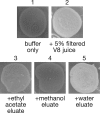Formulation of a defined V8 medium for induction of sexual development of Cryptococcus neoformans
- PMID: 18776031
- PMCID: PMC2570290
- DOI: 10.1128/AEM.00970-08
Formulation of a defined V8 medium for induction of sexual development of Cryptococcus neoformans
Abstract
For over 3 decades, sexual development in the human fungal pathogen Cryptococcus neoformans and other fungi has been initiated by growing compatible mating partners on V8 juice medium. Although this medium is an efficient inducer of sexual development, the mechanism by which it promotes the process is unknown. To understand how V8 juice medium induces sexual development, we attempted to purify inducing factors from V8 juice, and we carried out a complete compositional analysis of V8 juice. We discovered that no single factor is responsible for the effects of V8 juice medium. Rather, the unique composition of V8 juice medium provides the proper nutrient composition for inducing and sustaining complete sexual development. Utilizing these findings, we developed a defined V8 (DV8) medium that mimics V8 juice medium in sexual development assays. Then, using DV8 as a tool, we explored the roles that specific molecules play in enhancing sexual development. Surprisingly, we discovered that copper is a key factor, leading to an upregulation of the mating pheromone genes MFa and MFalpha, both required for the initial steps in sexual development. The utilization of DV8 to investigate the effects of copper on sexual development presented here is an example of how defining the conditions that induce sexual development will advance the study of C. neoformans.
Figures






References
-
- Alspaugh, J. A., R. C. Davidson, and J. Heitman. 2000. Morphogenesis of Cryptococcus neoformans, p. 217-238. In J. F. Ernst and A. Schmidt (ed.), Dimorphism in human pathogenic and apathogenic yeasts, vol. 5. Contributions to Microbiology. Karger, Basel, Switzerland. - PubMed
-
- Ausubel, F., R. Brent, R. Kingston, D. Moore, J. Seidman, J. Smith, and K. Struhl (ed.). 1997. Current protocols in molecular biology, vol. 2. John Wiley and Sons, Inc., Boston, MA.
-
- Banuett, F., and I. Herskowitz. 1994. Morphological transitions in the life cycle of Ustilago maydis and their genetic control by the a and b loci. Exp. Mycol. 18:247-266.
-
- Brysch-Herzberg, M. 2004. Metschnikowia kunwiensis comb. nov., the teleomorph of Candida kunwiensis. FEMS Yeast Res. 4:605-607. - PubMed
-
- Casadevall, A., and J. R. Perfect. 1998. Cryptococcus neoformans. ASM Press, Washington, DC.
Publication types
MeSH terms
Substances
Grants and funding
LinkOut - more resources
Full Text Sources

